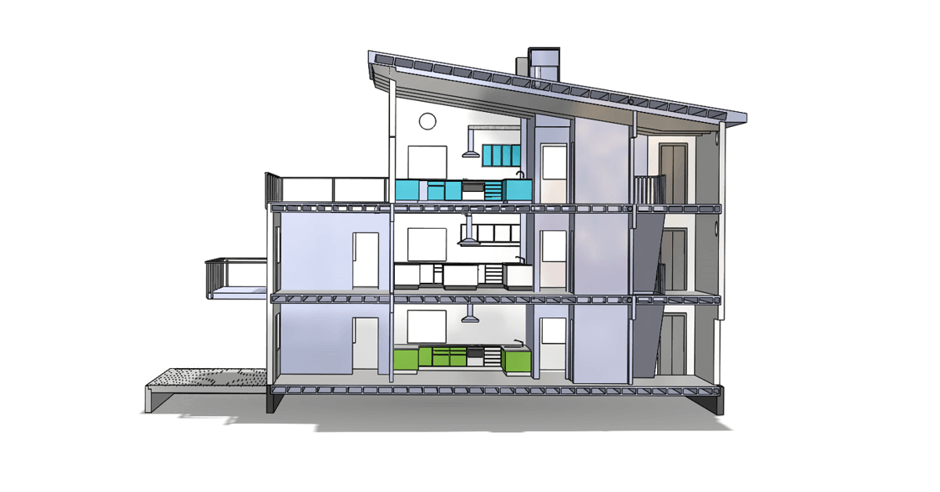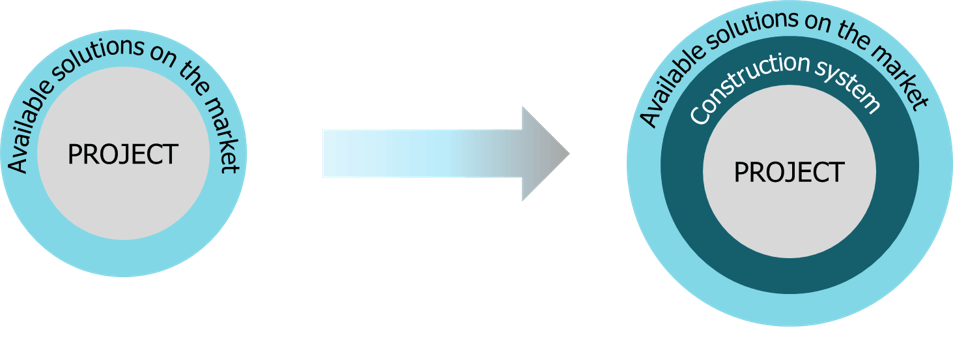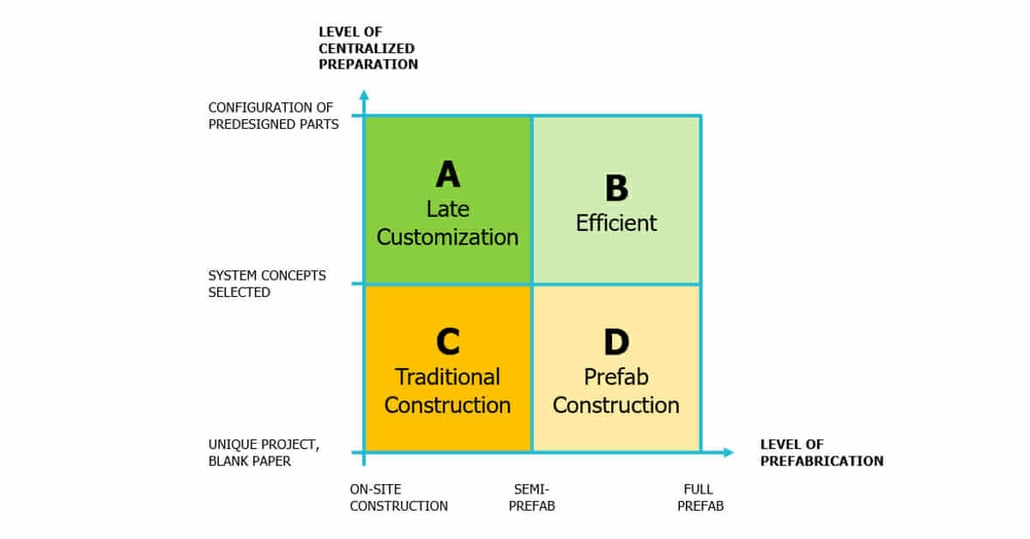For example, despite the promise of prefabrication to deliver higher quality at lower cost, there’s an evident risk that product quality is sacrificed for process efficiency. And even these process benefits can be questioned compared to improved on-site production methods.
What’s clear is that construction companies are looking for ways to improve productivity.
What’s also clear is that there’s not a one-size-fits-all solution.
Construction has a hard time to match the productivity of other industries
Configurable Construction to Meet Stakeholder Needs
Industry stakeholders want different things and these differences are driven by location and climate, regulations, respect for local traditions and the balance between the needs of construction companies, real estate owners and consumers.
This variety of needs is well suited to a modular approach, where different modules can be interchanged and rearranged thanks to standardized interfaces. The result is a construction system that can be configured to meet the needs of the market and provide solutions to satisfy all stakeholders.
Configurable construction systems can add value for construction companies and end customers through increased productivity, reduced lead-times and improved quality and product performance. This article looks at how companies can move from more traditional, custom-crafted construction to a configurable, truly industrialized system that meets all stakeholder needs.

Before starting out on a journey to create a configurable system, it’s important to set clear targets and plan how to reach them. These targets must be set specifically for your organization and will depend on company strategy, legacy and starting point.
Some companies see competence limitations in construction design as one of the biggest risks, and therefore set design re-use and CAD-automation as one of the main targets for their construction system. Others focus on direct material savings, quality improvements, value add for customers or digitalization. Successful companies understand what to focus on, how to set targets and how to connect them to actionable KPIs.
If the scope is wide, there will be reason to question whether it’s possible to select one technical or process solution for the whole range. For example, in a high-value segment a standardized kitchen setup might be used to enable a high degree of prefab. But in a high-price segment, the end customer wants more freedom to design the kitchen, including cabinet interiors, pushing the variance point later in time, pushing down the possible prefab degree.
One of the biggest long-term effects of utilizing a construction system is to be able to improve it continuously over time. Project-based businesses traditionally have a hard time to close feedback loops and continuously improve the product over time. Instead, there’s a risk that the wheel is reinvented in each new project. Construction is project based by nature, but this does not stop the central definition and governance of a construction system.

While the potential value is great, if you approach a new construction system from the wrong angle it can lead to big problems. Even when interfaces are in the right position and module variants are specified according to market demands, value will not materialize unless your processes, IT-systems, suppliers and company culture are adapted and aligned.
If strategies are not aligned properly, and not incorporated into the construction system itself, there will be a gap between company vision and implementation.
Experience suggests that many companies fail to properly assure that the construction system is flexible enough to be used in construction projects with different needs, thereby forcing projects to depart from set interfaces. Other companies risk focusing more on internal needs than the needs of end users, resulting in poor product performance. If you don’t attack these issues head on, your investment in productivity improvements is likely to fail.
Configurable Construction Systems and Prefab
A common misconception is that moving to prefabricated construction elements is the same thing as implementing a construction system.
The choice whether production should be located onsite or offsite is part of the construction system’s supply chain strategy, and it’s not clear that a bigger prefabricated share will help realize productivity improvements. For example, market requirements, such as flexibility and late customization, may drive production activities to onsite.
It’s important to carefully match product flexibility with process capability and customer value. For example, customization that generates significant customer value can be made onsite, while other elements should be optimized for efficiency and prepared offsite.
A construction system should rather be defined as a system prepared for configuration.
The first step is technology selection, i.e. standardizing on a specific frame system or multiple systems depending on market requirement. The second step is to have predesigned parts that are configured into a building. The higher the degree of centralized preparation, the less work needed in the design of each building. In reality, different parts of the building system will have different levels of preparation depending on the market challenge. Following this, the level of prefabrication can be optimized for each part to reach efficiency and configurability targets.

How to Start?
Construction has some of the most complex and extensive products of any industry, varying from large buildings to huge infrastructure projects. One of the earliest and most important decisions is how to scope the construction system.
A building is a complex system made up of numerous sub-systems structured in multi-layered hierarchies. Dependencies between sub-systems and variance of execution between projects drive complexity in the design, production and maintenance of a building.
Even if the long-term vision is to have all or at least most of the building’s sub-systems as part of a construction system, it makes sense to slice things up in bite size pieces. Before digging into each sub-system, you can benefit from analyzing the current state and identify which sub-system has most potential in relation to investment needs. This enables you to plan the overall journey to a configurable system and materialize that potential in iterative steps, starting with the part of the product that will give most return on investment.
Industry Disruption: Risk or Opportunity?
New actors tend to disrupt markets and leave established actors behind if they fail to adapt. The construction industry is likely to see an increasing level of disruption in the coming years, especially in some markets.
Decentralized production, complex permit processes, exposure to economic cycles, competence shortage and a multifaceted legacy are just some of the challenges facing the industry. What has been considered efficient before is no longer good enough. Industry specific conditions has held the industry back from some of the technological and organizational advances seen elsewhere.
As innovation continues at speed, we’ve reached a threshold where systems, technologies and processes can deal with the needs of the construction industry, and we’re seeing how leading organizations are adopting. Companies that find the balance of when and what to invest in will be greatly awarded, even if it’s a fine line and there are several uncertainties going forward. Whatever the right path is, you will have to be fast, flexible and efficient, which makes an investment in a configurable construction system important. Configurable construction will enable you to meet different stakeholder needs, stay on top of market trends and keep your organization together.
In the near future we’re likely to see new constellations of vertical integration. Larger construction companies will take a life cycle management approach to buildings, where the second and third tenant is a new customer. And this places new requirements on the construction system, with stable interfaces for future upgrades, and on the information management systems needed to handle the lifecycle perspective of the buildings.
The construction industry is changing fast and a construction system that can be configured to meet changing needs could well be a prerequisite for success. Either you adapt as competitors set the framework for the future or you lead the change.


